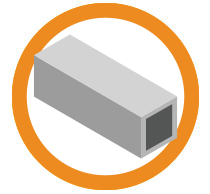
What are TVOCs?
The Total Volatile Organic Compound (TVOC) level is a measurement of the sum of all of the Volatile Organic Compounds (VOCs) found in an air sample.
“Organic” means it has at least one carbon atom. “Volatile” means it is a gas under normal atmospheric conditions, so it has low boiling point and a high vapour pressure. That means these chemicals evaporate easily and often react with other substances in the air – making them volatile.
Therefore, VOCs are a combination of gases and odours emitted from many different toxins and chemicals found in everyday products, such as:
- Benzene - found in tobacco smoke, paint thinner, deodorizers, air fresheners, furniture polish
- Formaldehyde - found in disinfectants, furniture upholstery, carpets, plywood
- Ethylene glycol - found in cleaning agents, personal care products, perfumes
- Methylene chloride - found in spot removers, dry cleaned clothes, fabric cleaners, commercial solvents, air conditioner refrigerant
- Tetrachloroethylene - used in solvents, dry cleaning, paint strippers
- Toluene - used in paint, metal cleaners, adhesives
If you’ve ever opened a marker pen and smelled that chemical smell, that is the scent of VOCs!
VOCs can cause serious health effects in both the short and long term. Problems can vary from minor eye, nose and throat irritations all the way to liver and kidney damage or cancer, depending on the severity of exposure.
How Can You Monitor VOCs?
The best way to identify the presence of VOCs is by placing air quality monitors in areas of concern, and diligently track and record the TVOC levels.
With an air quality monitor, you can spot trends in your TVOC readings and perhaps the potential sources of VOCs. For example, during office cleaning hours, TVOC readings may increase dramatically, because many cleaning materials emit VOCs.
With an air quality monitor, you will know where the best positions for air purifiers are, and also times of the day that increased ventilation would be beneficial.
What levels of TVOC are safe?
Just to make things really confusing, TVOC measurements are provided in micrograms per cubic meter (ug/m3), milligrams per cubic meter of air (mg/m3), parts per million (ppm), or parts per billion (ppb).
Below is a TVOC levels chart expressed as milligrams per cubic meter (mg/m3) – which is used by the SmartAir Qingping Pro Air Quality Monitor - and also micrograms per cube meter (ug/m3):
| TVOC level mg/m3 | TVOC level ug/m3 | Level of concern |
| < 0.3 mg/m3 | 300 ug/m3 | Low |
| 0.3 - 0.5 mg/m3 | 300 - 500 ug/m3 | Acceptable |
| 0.5 - 1.0 mg/m3 | 500 - 1000 ug/m3 | Marginal |
| 1 - 3 mg/m3 | 1000 - 3000 ug/m3 | High |
Basically, in order to be safe you want the TVOC to be below 0.3 mg/m3 or 300 ug/m3. However, it is still acceptable for the TVOC to be up to 0.5 mg/m3 or 500 ug/m3. All levels which are higher than that should raise concern.
How to remove TVOCs from your room?
While HEPA filters are superstars when it comes to capturing PM2.5, pet allergens, pollen, viruses, mould and bacteria, they are not recommended for those nasty TVOCs. These hazardous gases normally pass right through a HEPA.
Fortunately, activated carbon/charcoal filters are available and will react with these hazardous gases to remove them from the air.
How does activated charcoal work?
The carbon filter mesh consists of many carbon granules that have been treated to become extremely porous.
This means that they have huge surface areas. In fact, just one gram of activated charcoal can have approximately 1,000m² of surface area!
This massive surface area allows the carbon granules to trap many harmful gas molecules, giving you fresh odourless and chemical-free air.
Do I still need a HEPA Filter?
Activated carbon is designed to capture smells and gases like VOCs. It is not made for particulates in general.
In fact, activated carbon is made to be as porous as possible to get as much air into contact with the carbon. Therefore, it does not remove high amounts of small particles. Thus, we still need a HEPA.
To conclude, although TVOCs can be dangerous, they are easily monitored and their affects can be neutralized with the correct equipment.
Smart Air’s Qing Ping Air Monitor and one of Smart Air’s Air Purifiers are the perfect the combination when it comes to combatting this insidious danger.







